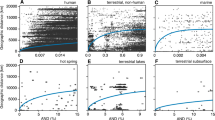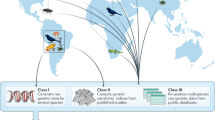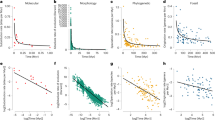Abstract
Global efforts to conserve species have been strongly influenced by the heterogeneous distribution of species diversity across the Earth. This is manifest in conservation efforts focused on diversity hotspots1,2,3. The conservation of genetic diversity within an individual species4,5 is an important factor in its survival in the face of environmental changes and disease6,7. Here we show that diversity within species is also distributed unevenly. Using simple genealogical models, we show that genetic distinctiveness has a scale-free power law distribution. This property implies that a disproportionate fraction of the diversity is concentrated in small sub-populations, even when the population is well-mixed. Small groups are of such importance to overall population diversity that even without extrinsic perturbations, there are large fluctuations in diversity owing to extinctions of these small groups. We also show that diversity can be geographically non-uniform—potentially including sharp boundaries between distantly related organisms—without extrinsic causes such as barriers to gene flow or past migration events. We obtained these results by studying the fundamental scaling properties of genealogical trees. Our theoretical results agree with field data from global samples of Pseudomonas bacteria. Contrary to previous studies8, our results imply that diversity loss owing to severe extinction events is high, and focusing conservation efforts on highly distinctive groups can save much of the diversity.
This is a preview of subscription content, access via your institution
Access options
Subscribe to this journal
Receive 51 print issues and online access
$199.00 per year
only $3.90 per issue
Buy this article
- Purchase on Springer Link
- Instant access to full article PDF
Prices may be subject to local taxes which are calculated during checkout




Similar content being viewed by others
References
Prendergast, J. R., Quinn, R. M., Lawton, J. H., Eversham, B. C. & Gibbons, D. W. Rare species, the coincidence of diversity hotspots and conservation strategies. Nature 365, 335–337 (1993)
Myers, N., Mittermeier, R. A., Mittermeier, C. G., da Fonseca, G. A. B. & Kent, J. Biodiversity hotspots for conservation priorities. Nature 403, 853–858 (2000)
Gaston, K. J. Global patterns in biodiversity. Nature 405, 220–227 (2000)
Ehrlich, P. R. & Wilson, E. O. Biodiversity studies: science and policy. Science 253, 758–761 (1991)
Faith, D. P. Genetic diversity and taxonomic priorities for conservation. Biol. Conserv. 68, 69–74 (1994)
Amos, A. & Balmford, A. When does conservation genetics matter? Heredity 87, 257–265 (2001)
Frankham, R. et al. Do population size bottlenecks reduce evolutionary potential? Anim. Conserv. 2, 255–260 (1999)
Nee, S. & May, R. M. Extinction and the loss of evolutionary history. Science 278, 692–694 (1997)
Hudson, R. R. Gene genealogies and the coalescent process. Oxf. Surv. Evol. Biol. 7, 1–44 (1990)
Barton, N. H. & Wilson, I. Genealogies and geography. Phil. Trans. R. Soc. Lond. B 349, 49–59 (1995)
Notohara, M. The structured coalescent process with weak migration. J. Appl. Prob. 38, 1–17 (2001)
Wilkins, J. F. & Wakeley, J. The coalescent in a continuous, finite, linear population. Genetics 161, 873–888 (2002)
Wright, S. Isolation by distance. Genetics 28, 114–138 (1943)
Fisher, R. A. The distribution of gene ratios for rare mutations. Proc. R. Soc. Edinb. 50, 205–220 (1930)
Watterson, G. A. On the number of segregating sites in genetical models without recombination. Theor. Popul. Biol. 7, 256–276 (1975)
Wakeley, J. & Takahashi, T. Gene genealogies when the sample size exceeds the effective size of the population. Mol. Biol. Evol. 20, 208–213 (2003)
Cho, J. C. & Tiedje, J. M. Biogeography and degree of endemicity of fluorescent Pseudomonas strains in soil. Appl. Environ. Microbiol. 66, 5448–5456 (2000)
Watterson, G. A. Mutant substitutions at linked nucleotide sites. Adv. Appl. Prob. 14, 206–224 (1982)
Nei, M. Molecular Evolutionary Genetics (Columbia University Press, New York, 1987)
Irwin, D. E. Phylogeographic breaks without geographic barriers to gene flow. Evolution 56, 2383–2394 (2002)
Hewitt, G. M. The genetic legacy of the Quaternary ice ages. Nature 405, 907–913 (2000)
Willis, K. J. & Whittaker, R. J. The refugial debate. Science 287, 1406–1407 (2000)
Cann, R. Genetic clues to dispersal in human populations: retracing the past from the present. Science 291, 1742–1748 (2001)
Finlay, B. J. Global dispersal of free-living microbial eukaryote species. Science 296, 1061–1063 (2002)
Whitaker, R. J., Grogan, D. W. & Taylor, J. W. Geographic barriers isolate endemic populations of hyperthermophilic archea. Science 301, 976–978 (2003)
Bar-Yam, Y. Multi-scale variety in complex systems. Complexity 9, 37–45 (2004)
Crozier, R. H. Preserving the information content of species: genetic diversity, phylogeny, and conservation worth. Annu. Rev. Ecol. Syst. 28, 243–268 (1997)
Moritz, C. Defining evolutionarily significant units for conservation. Trends Ecol. Evol. 9, 373–375 (1994)
Acknowledgements
This work was funded in part by the National Science Foundation. We are indebted to S. Hubbell, S. Pimm, J. Wakeley, M. Kardar and C. Goodnight for comments. We thank J.-C. Cho and J. Tiedje for comments and for providing the original figure with data from ref. 17.
Author information
Authors and Affiliations
Corresponding author
Ethics declarations
Competing interests
The authors declare that they have no competing financial interests.
Supplementary information
Rights and permissions
About this article
Cite this article
Rauch, E., Bar-Yam, Y. Theory predicts the uneven distribution of genetic diversity within species. Nature 431, 449–452 (2004). https://doi.org/10.1038/nature02745
Received:
Accepted:
Issue Date:
DOI: https://doi.org/10.1038/nature02745
This article is cited by
-
Genetic Diversity and Geographic Expansion in Syagrus coronata (Mart) Becc. (Arecaceae), A Highly Exploited Palm Endemic to the Brazilian Semiarid Region: Suggestion for Conservation Policies
Tropical Plant Biology (2023)
-
Ecological, genetic and evolutionary drivers of regional genetic differentiation in Arabidopsis thaliana
BMC Evolutionary Biology (2020)
-
Effect of vegetative filter strips on the dynamics of E. coli biofilm-building potential and expression of virulence factors at Mau, Kenya
Energy, Ecology and Environment (2018)
-
Digging up the roots of an insular hotspot of genetic diversity: decoupled mito-nuclear histories in the evolution of the Corsican-Sardinian endemic lizard Podarcis tiliguerta
BMC Evolutionary Biology (2017)
-
Asymptotics of the Minimal Clade Size and Related Functionals of Certain Beta-Coalescents
Acta Applicandae Mathematicae (2016)
Comments
By submitting a comment you agree to abide by our Terms and Community Guidelines. If you find something abusive or that does not comply with our terms or guidelines please flag it as inappropriate.



